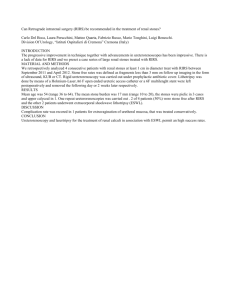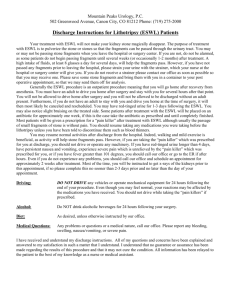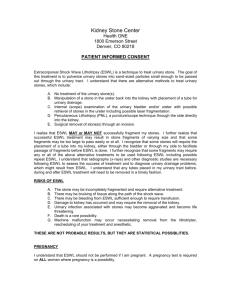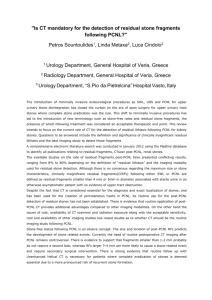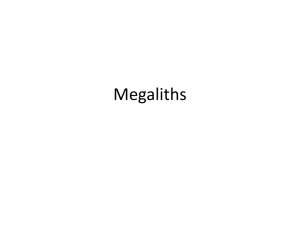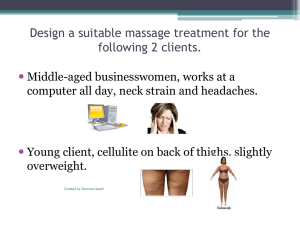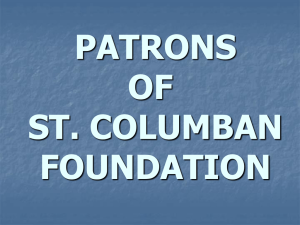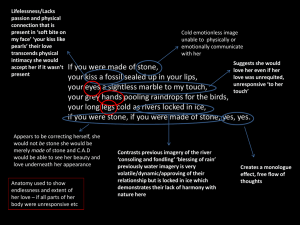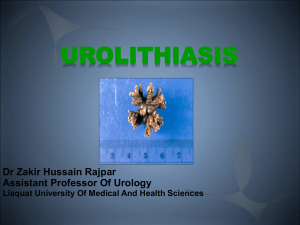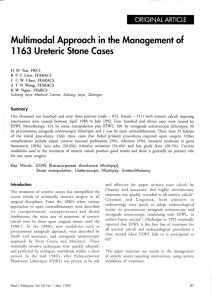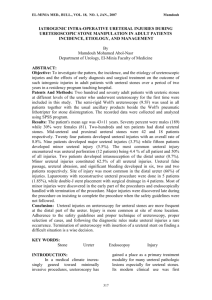Surgical Treatment of Renal and Ureteral Stones
advertisement
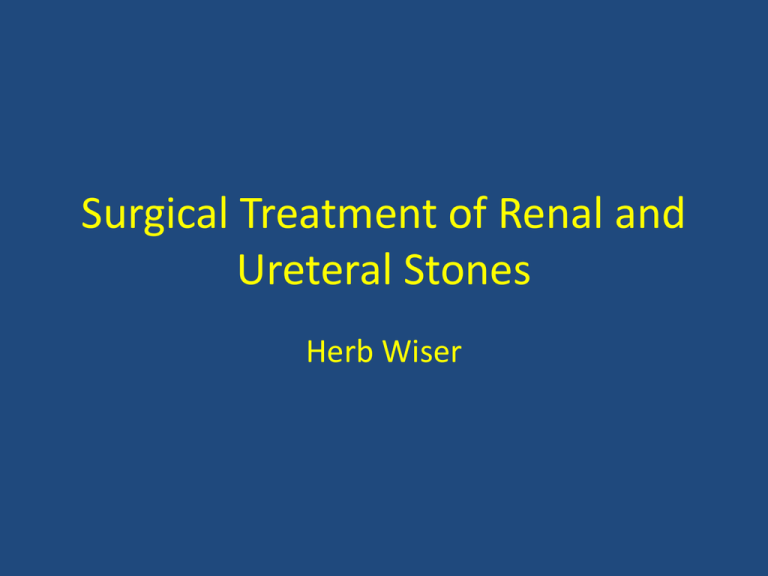
Surgical Treatment of Renal and Ureteral Stones Herb Wiser Treatment Modalities • • • • ESWL (extracorporeal shock wave lithotripsy) Ureteroscopy PCNL (percutaneous nephrolithotomy) Open or laparoscopic surgery – Ureterolithotomy – Anatrophic nephrolithtomy ESWL • • • • “Bath tub” treatment Shock waves to break stones Non-invasive Results worse for Bigger stones Stones located in the lower pole of the kidney Hard stones Electrohydrolic (Spark gap) Energy Sources and Configurations Electromagnetic Piezoelectric Mechanism of Action – Electrohydraulic • Power source at F1 • Generated in water medium • Contained in a ellipsoid shield • Waves (energy) concentrated at F2 Prognostic factors for ESWL success Wang LJ et al. Eur Urol 2005 • <900 HU (72% success) vs >900 (35%) • Size <12mm (78%) vs >12 (26%) • Non-Lower pole (70%) vs Lower pole (46%) Pareek G et al. Urology 2005 • 24/29 pts (83%) with SSD <10cm were stone free • 6/35 pts (17%) with SSD >10cm were stone free Success Rates ESWL • Renal - 55-75% (lowest for lower pole stones) • Proximal Ureter – <1cm – 90% – >1cm – 70% • Mid/Distal Ureter – <1cm – 85% – >1cm – 75% Contraindications to ESWL • • • • • Pregnancy Coagulopathy UTI Intrarenal vascular calcifications Renal artery aneurysm or AAA Complications of ESWL • Retroperitoneal Hematoma – >25% incidence on imaging – <0.5% clinically significant Complications of ESWL Complications of ESWL • Pain from stone fragment passage – 25-50% of pts • Steinstrasse – ~5% of pts http://radiologyinthai.blogspot.co m/2010_12_01_archive.html Complications of ESWL • ? Long term effects of ESWL – DM and HTN – Retrospective studies show increased incidence of DM and HTN in stone formers – Is this because a stone formers have worse dietary habits? – Prospective trials show no increase in DM/HTN, but follow up is limited (a few years) Ureteroscopy • • • • • Placing small scope into ureter or kidney Flexible or rigid scopes Remove the stone (‘basket’, ‘loop’, ‘snare’) Break the stone - Laser May leave a stent (surgeon’s discretion) Uretero scopes Flexible Ureteroscopy Grasso M. Arch Esp Urol 2008. http://www.windsorurology.co.uk/ Image Quality Laser Lithotripsy Laser Lithotripsy Stone Basketing Ureteroscope Considerations • Flexible Scope outer sizes 8.5-10 Fr – Working channel 3.5Fr • Semirigid Scope @ tip 7-9 Fr proximally 6-13.5 Fr one is 4.5/6.5 Fr – Working channel up to 3-6 Fr Laser Lithotripsy • Holmium:YAG laser is most common type for laser lithotripsy – Erbium:YAG and Thulium lasers under development, potentially superior to Ho:YAG, not widespread – Very limited depth of penetration (0.4mm) • Limits tissue damage – Highly effective at lithotripsy Success Rates Ureteroscopy – Old Data • Renal - ~70-80% (lowest for lower pole stones) – Stone clearance decreases with increasing stone size • Proximal Ureter - ~80% • Mid Ureter – 80-90% • Distal Ureter - ~95% Complications of URS • Ureteral Perforation – ~5% – Treatment is stenting (~6 weeks) – Can result in stricture in the long term (1% of all URS) • Ureteral Stricture – Could be due to stone or URS • Ureteral Avulsion – Rare but really, really bad Stents • • • • • Polymer tubes from kidney to bladder Keep the ureter open Dilates the ureter Patient removal vs surgeon removal Symptoms – Bladder spasms – Flank pain – hematuria Stents People generally HATE them, but they are a necessary evil. Percutaneous Approach • • • • Big stones (>2cm) Stones likely to be struvite Difficult anatomy (calyceal diverticulum, etc) ESWL failures PCNL http://www.actasurologicas.info Lithotripsy for PCNL • Ultrasonic Lithotriptor • Pneumatic Lithotriptor • Laser (Ho:YAG) Ultrasonic Lithotriptor • • • • • • • • Electric current stimulates piezoelectric crystal Crystals expand and contract Creates vibrations at ~25,000 Hz Transmitted to tip of probe “Drills” the stone Strictly mechanical energy No heat, cavitation or shock waves Suctions fragments through the center of the wand Pneumatic Lithotripsy • Like a jackhammer • Depression of foot pedal forces compressed air to handpiece • Metal projectile is propelled • Repetitive mechanical pounding • Mechanical energy transferred to tip • Fragmentation by compression forces Success Rates PCNL • Renal stones (even staghorns) – 80-90% • Proximal ureteral stones – 85% • Stone clearance rates are affected by renal anatomy and adequacy of access Access for PCNL • In the US – 80-90% by IR – 10-20% by urology – When IR involved, can be just for initial PCN tube or they may also dilate the tract and place the final PCN tube, highly variable Contraindications to PCNL • UTI • Coagulopathy • No safe access possible Complications of PCNL • Bleeding – Kidney is very vascular – each one gets 10% of cardiac output Complications of PCNL • Sepsis – highest risk is with infection stones (struvite) • Pneumo/Hydrothorax – Highest risk with upper pole puncture • Up to 10% of upper pole punctures in some studies • Colon/Spleen injury – Very rare Laparoscopy / Open • Rarely necessary in 2009 • Can use for extreme cases where compliance is a concern • Higher morbidity, worse cosmesis, longer recovery Questions?
